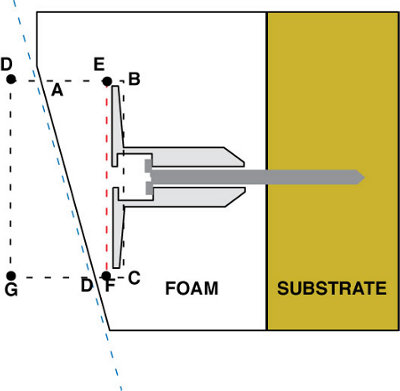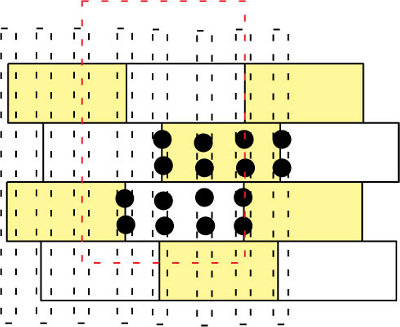
When I do technical seminars about EIFS, one of the most frequent questions is, “Should I use adhesives or mechanical fasteners (screws plus washers), or even both, to attach the foam insulation to the wall?” The answer depends on a number of factors, and sometimes you have no choice about which to use. Here is some information about attachment methods for your arsenal of information to pass on to customers.
Substrate vs. Actual Wall Surface
With adhesives, the outermost surface of the substrate is the key. A concrete wall covered by a waterproofing coating is not a concrete wall in terms of the substrate-the adhesive bonds to the waterproofing, which is not a suitable surface but raw concrete is fine. Although it’s sometimes possible to find an adhesive that will stick to paint and other common surface coatings, it is risky. Even when test patches of adhesive are done first-and which indicate a good bond-there have been many cases over the years of what appeared to be a well-attached EIFS coming off the wall in huge sheets. In cases like this, it’s best to clean the coating off the wall down to the bare substrate, or use mechanical fasteners. If you can’t get the old coating off the wall, you can attach metal lath to the wall with shot fasteners and use adhesives to glue the foam to the lath.The physical condition of the substrate also matters. Crumbling, old masonry needs to be brought into serviceable condition for adhesives or mechanical fasteners to be used. Especially with retrofit EIFS applications on existing buildings, sometimes tests of various mechanical fastener screws are needed to find one that consistently gets a good grip.
Strength of Attachment
On sound, strong substrates, adhesives give a stronger bond. This can make a difference on buildings in high wind areas, such as where hurricanes occur and on tall buildings. Because the adhesive spreads out the wind forces that are trying to pull off the (weak) foam over a large area, the stresses in the foam are much lower. With mechanical fasteners, the high “point loads” at the washers limit the strength of attachment.On gypsum-based sheathing substrates, the mechanical fasteners must go into the stud framing. The gypsum board is not strong enough to resist the pulling force of a screw drilled into it. This means the contractor must know where the studs are located. Putting longs screws through thick foam and “hitting” the stud face will also require care.

The recessed fastener “pocket” is made with a
hole saw and is bounded by A-B-C-D. The plug is a cylindrical piece of EPS that
friction-fits into the hole, and is bounded by points E-F-G-H. The outside face
of the plug is trimmed to follow the shape of the foam shape, along the dotted
blue diagonal line.
Foam Shapes
Foam shapes can present a special problem for mechanical fasteners. The problem arises because the outside of the foam shape is often curved or beveled, so the fastener washer won’t be flush if driven straight in. There are a couple of ways around this:Use a “base layer” of thin, flat foam that is mechanically fastened and then glue the foam shape on top of the base layer.
Pre-drill a “core pocket” using a drill hole saw (the pocket being perpendicular to the substrate). The fastener washer is then fit into the hole and screwed into the substrate. Then a round “plug” of EPS is placed in the hole, and sanded to follow the contour of the foam shape. (See Drawing 1 that shows the pocket and fastener.)
Adjustments for Wall Flatness
Adhesives have the advantage that the thickness of the adhesive layer, about 1/8 inch, allows for taking into account minor irregularities in the substrate-such as a wavy substrate. This allows the front edges of the foam pieces to line up.Mechanical fasteners hold on to the wall by a clamping action. Thus, the washer must be screwed down tight for the fastener to properly hold the foam to the wall. This means that there is less control in adjusting the outside face of the foam than there is with adhesives.

The dotted vertical rectangles are the studs at
16 inches on center. The white and yellow rectangles are the foam boards, in
the typical “running bond” pattern. The large, red dotted rectangle is a
4-foot-by-8-foot piece of sheathing. Note how it is offset but also still lines
up (unfortunately) with the foam board edges. The black dots are the fastener
washers.
Fastener Patterns
There are a myriad of fastener patterns when using mechanical fasteners. This is especially true if the substrate is “screwable”-such as plywood or OSB; you can put them in wherever you want. But with gypsum board substrates, the fastener must go into the stud, which means the options for patterns are more limited. Generally six to nine fasteners per 2-feet-by-4-feet insulation board are used.One issue that comes up is when the fasteners are placed between the ends of foam boards and hold down two pieces of foam at once. The problem is that this approach makes the insulation board edges line up with the seams between the sheathing substrate pieces. This can induce cracking. Drawing 2 shows how this occurs.
Rasping
Making the outside surface of the EIFS insulation boards co-planar by sanding (aka rasping) is standard procedure when installing EIFS. It’s easy enough to do with adhesively attached insulation. With mechanically attached insulation there can be some issues, such as:The fastener washer is not flush with the outside face of the foam, so the rasping, at the fastener, can’t occur. Solution: reset the fastener slightly to get in below the surface.
Fasteners are sometimes used between two insulation boards, and hold down both boards at their edges. Compounding this is the fact that the board-to-board interface is one of the main areas where offsets can occur in the plane of the insulation’s outer face. Thus, this area needs to be rasped. It’s hard to do with the washer in the way. Solution: same as above-seat the fastener just below the insulation surface.




Report Abusive Comment